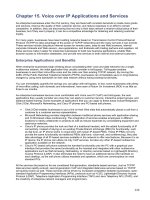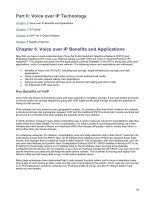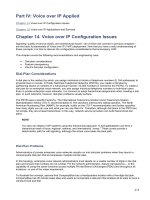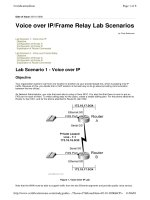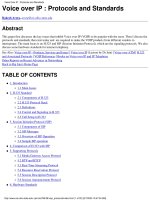Voice over IP : Protocols and Standards
Bạn đang xem bản rút gọn của tài liệu. Xem và tải ngay bản đầy đủ của tài liệu tại đây (121.98 KB, 20 trang )
Voice over IP : Protocols and Standards
Rakesh Arora,
Abstract
This paper first discusses the key issues that inhibit Voice over IP (VOIP) to be popular with the users. Then I discuss the
protocols and standards that exist today and are required to make the VOIP products from different vendors to
interoperate. The main focus is on H.323 and SIP (Session Initiation Protocol), which are the signaling protocols. We also
discuss some hardware standards for internet telephony.
See Also: Voice over IP - Products, Services and Issues | Voice over IP (Lecture by Dr Jain) | Voice over ATM | H.323
and Associated Protocols | VOIP References | Books on Voice over IP and IP Telephony
Other Reports on Recent Advances in Networking
Back to Raj Jain's Home Page
TABLE OF CONTENTS
1. Introduction
1.1 Main Issues
❍
●
2. H.323 Standard
2.1 Components of H.323
❍
2.2 H.323 Protocol Stack
❍
2.3 Definitions
❍
2.4 Control and Signaling in H.323
❍
2.5 Call Setup in H.323
❍
●
3. Session Initiation Protocol (SIP)
3.1 Components of SIP
❍
3.2 SIP Messages
❍
3.3 Overview of SIP Operation
❍
3.4 Sample SIP operation
❍
●
4. Comparison of H.323 with SIP
●
5. Supporting Protocols
5.1 Media Gateway Access Protocol
❍
5.2 RTP and RTCP
❍
5.3 Real Time Streaming Protocol
❍
5.4 Resource Reservation Protocol
❍
5.5 Session Description Protocol
❍
5.6 Session Announcement Protocol
❍
●
6. Hardware Standards
●
Voice Over IP : Protocols and Standards
(1 of 20) [2/7/2000 10:47:54 AM]
6.1 SCBus
❍
6.2 S.100
❍
7. Summary
●
Appendix A: Functions of the key protocols and standards
●
References
●
List of Acronyms
●
INTRODUCTION
Voice over IP (VOIP) uses the Internet Protocol (IP) to transmit voice as packets over an IP network. So VOIP can be
achieved on any data network that uses IP, like Internet, Intranets and Local Area Networks (LAN). Here the voice signal
is digitized, compressed and converted to IP packets and then transmitted over the IP network. Signaling protocols are
used to set up and tear down calls, carry information required to locate users and negotiate capabilities.One of the main
motivations for Internet telephony is the very low cost involved. Some other motivations are:
Demand for multimedia communication
●
Demand for integration of voice and data networks
●
1.1 Main Issues
For VOIP to become popular, some key issues need to be resolved. Some of these issues stem from the fact that IP was
designed for transporting data while some issues have arisen because the vendors are not conforming to the standards.
The key issues are discussed below [Munch98]:
Quality of voice
As IP was designed for carrying data, so it does not provide real time guarantees but only provides best effort
service. For voice communications over IP to become acceptable to the users, the delay needs to be less than a
threshold value and the IETF (Internet Engineering Task Force) is working on this aspect. To ensure good quality
of voice, we can use either Echo Cancellation, Packet Prioritization (giving higher priority to voice packets) or
Forward Error Correction [Micom] .
●
Interoperability
In a public network environment, products from different vendors need to operate with each other if voice over IP
is to become common among users. To achieve interoperability, standards are being devised and the most common
standard for VOIP is the H.323 standard, which is described in the next section.
●
Security
This problem exists because in the Internet, anyone can capture the packets meant for someone else. Some security
can be provided by using encryption and tunneling. The common tunneling protocol used is Layer 2 Tunneling
protocol and the common encryption mechanism used is Secure Sockets Layer (SSL).
●
Integration with Public Switched Telephone Network(PSTN)
While Internet telephony is being introduced, it will need to work in conjunction with PSTN for a few years. We
need to make the PSTN and IP telephony network appear as a single network to the users of this service.
●
Scalability
As researchers are working to provide the same quality over IP as normal telephone calls but at a much lower cost,
so there is a great potential for high growth rates in VOIP systems. VOIP systems needs to be flexible enough to
grow to large user market and allow a mix of private and public services.
●
Voice Over IP : Protocols and Standards
(2 of 20) [2/7/2000 10:47:54 AM]
Back to Table of Contents
2. H.323 STANDARD
This is the ITU-T’s (International Telecommunications Union) standard that vendors should comply while providing
Voice over IP service. This recommendation provides the technical requirements for voice communication over LANs
while assuming that no Quality of Service (QoS) is being provided by LANs. It was originally developed for multimedia
conferencing on LANs, but was later extended to cover Voice over IP. The first version was released in 1996 while the
second version of H.323 came into effect in January 1998. The standard encompasses both point to point communications
and multipoint conferences. The products and applications of different vendors can interoperate if they abide by the
H.323 specification.
2.1 Components of H.323
H.323 defines four logical components viz., Terminals, Gateways, Gatekeepers and Multipoint Control Units (MCUs).
Terminals, gateways and MCUs are known as endpoints. These are discussed below [DataBeam]:
2.1.1 Terminals
These are the LAN client endpoints that provide real time, two way communications. All H.323 terminals have to support
H.245, Q.931, Registration Admission Status (RAS) and Real Time Transport Protocol (RTP). H.245 is used for allowing
the usage of the channels, Q.931 is required for call signaling and setting up the call, RTP is the real time transport
protocol that carries voice packets while RAS is used for interacting with the gatekeeper.These protocols have been
discussed later in the paper. H.323 terminals may also include T.120 data conferencing protocols, video codecs and
support for MCU. A H.323 terminal can communicate with either another H.323 terminal, a H.323 gateway or a MCU.
2.1.2 Gateways
An H.323 gateway is an endpoint on the network which provides for real-time, two-way communications between H.323
terminals on the IP network and other ITU terminals on a switched based network, or to another H.323 gateway. They
perform the function of a "translator" i.e. they perform the translation between different transmission formats, e.g from
H.225 to H.221. They are also capable of translating between audio and video codecs. The gateway is the interface
between the PSTN and the Internet. They take voice from circuit switched PSTN and place it on the public Internet and
vice versa. Gateways are optional in that terminals in a single LAN can communicate with each other directly. When the
terminals on a network need to communicate with an endpoint in some other network, then they communicate via
gateways using the H.245 and Q.931 protocols.
2.1.3 Gatekeepers
It is the most vital component of the H.323 system and dispatches the duties of a "manager". It acts as the central point
for all calls within its zone (A zone is the aggregation of the gatekeeper and the endpoints registered with it) and provides
services to the registered endpoints. Some of the functionalities that gatekeepers provide are listed below
[DataBeam][H.323]:
Address Translation: Translation of an alias address to the transport address. This is done using the
translation table which is updated using the Registration messages.
Admissions Control : Gatekeepers can either grant or deny access based on call authorization, source and
destination addresses or some other criteria.
Call signaling : The Gatekeeper may choose to complete the call signaling with the endpoints and may
process the call signaling itself. Alternatively, the Gatekeeper may direct the endpoints to connect the Call
Voice Over IP : Protocols and Standards
(3 of 20) [2/7/2000 10:47:54 AM]
Signaling Channel directly to each other.
Call Authorization: The Gatekeeper may reject calls from a terminal due to authorization failure through the
use of H.225 signaling. The reasons for rejection could be restricted access during some time periods or
restricted access to/from particular terminals or Gateways.
Bandwidth Management: Control of the number of H.323 terminals permitted simultaneously access to the
network. Through the use of H.225 signaling, the Gatekeeper may reject calls from a terminal due to
bandwidth limitations.
Call Management: The gatekeeper may maintain a list of ongoing H.323 calls. This information may be
neccesary to indicate that a called terminal is busy, and to provide information for the Bandwidth
Management function.
2.1.4 Multipoint Control Units (MCU)
The MCU is an endpoint on the network that provides the capability for three or more terminals and gateways to
participate in a multipoint conference. The MCU consists of a mandatory Multipoint Controller (MC) and optional
Multipoint Processors (MP). The MC determines the common capabilities of the terminals by using H.245 but it does not
perform the multiplexing of audio, video and data. The multiplexing of media streams is handled by the MP under the
control of the MC. The following figure [Fig1] shows the interaction between all the H.323 components
Fig 1. Components of H.323
Back to Table of Contents
Voice Over IP : Protocols and Standards
(4 of 20) [2/7/2000 10:47:54 AM]
2.2 H.323 Protocol Stack
The following figure [Fig 2] shows the H.323 protocol stack. The audio, video and registration packets use the unreliable
User Datagram Protocol (UDP) while the data and control application packets use the reliable Transmission Control
Protocol (TCP) as the transport protocol. Except for the T.120 protocol, the other protocols are described in the paper.
The T.120 protocol is used for defining the data conferencing part.[Toga99]
Fig 2. The protocol stack of H.323
Back to Table of Contents
2.3 Definitions
2.3.1 Zone
The collection of a gatekeeper and the endpoints registered with it is called a zone.
2.3.2 Network Address
For each H.323 entity, a network address is assigned and this address uniquely identifies the H.323 entity on the network.
An endpoint may use different network addresses for different channels within the same call.
2.3.3 Alias Address
The alias address provides an alternate method of addressing the endpoint. It could be an email address, a telephone
number or something similar. An endpoint may have one or more alias addresses associated with it and is unique within a
Voice Over IP : Protocols and Standards
(5 of 20) [2/7/2000 10:47:54 AM]
zone.
2.3.4 TSAP Identifier
For each network address, each H.323 entity may have several TSAP (Transport layer Service Access Point) identifiers.
These TSAP identifiers allow multiplexing of several channels sharing the same network address. Endpoints have one
well known TSAP identifier defined : the Call Signaling Channel TSAP identifier. Gateways also have one well known
TSAP identifier defined : the RAS channel TSAP identifier and one well known multicast address defined : Discovery
Multicast Address [H.323]
Back to Table of Contents
2.4 Control and Signaling in H.323
H.323 provides three control protocols viz., H.225.0/Q.931 Call Signaling, H.225.0 RAS and H.245 Media Control.
H.225/ Q.931 is used in conjunction with H.323 and provides the signaling for call control. For establishing a call from a
source to a receiver host, the H.225 RAS (Registration, Admission and Signaling) channel is used. After the call has been
established, H.245 is used to negotiate the media streams.
2.4.1 H.225.0 : RAS
The RAS channel is used for the communication between the endpoints and the gatekeeper. Since the RAS messages are
sent over UDP (an unreliable channel), so it recommends timeouts and retry counts for messages. The procedures defined
by the RAS channel are [H.323]:
Gatekeeper discovery
This is the process that an endpoint uses to determine the gatekeeper with which it should register. The endpoint normally
multicasts a Gatekeeper Request (GRQ) message asking for its gatekeeper. One or more gatekeepers may respond with
the Gatekeeper Confirmation (GCF) message thereby indicating the willingness to be the gatekeeper for that endpoint.
The response includes the transport address of the gatekeeper’s RAS channel. Gatekeepers who do not want the endpoint
to register with it can send a Gatekeeper Reject (GRJ) message. If more than one gatekeeper responds with GCF, then the
endpoint may choose the gatekeeper and register with it. If no gatekeeper responds within a timeout interval, the endpoint
may retransmit the GRQ.
Endpoint Registration
This is the process by which an endpoint joins a zone and informs the gatekeeper of its transport and alias addresses. All
endpoints usually register with the gatekeeper that was identified through the discovery process. An endpoint shall send a
Registration Request (RRQ) to a gatekeeper. This is sent to the gatekeeper’s RAS channel Transport Address. The
endpoint has the network address of the gatekeeper from the gatekeeper discovery process and uses the well known RAS
channel TSAP Identifier. The gatekeeper shall respond with either a Registration Confirmation (RCF) or a Registration
Reject (RRJ). The gatekeeper shall ensure that each alias address translates uniquely to a single transport address. An
endpoint may cancel its registration by sending an Unregister Request (URQ) message to the gatekeeper. The gatekeeper
shall respond with an Unregister Confirmation (UCF) message. A gatekeeper may cancel the registration of an endpoint
by sending an Unregister Request (URQ) message to the endpoint. The endpoint shall respond with an Unregister
Confirmation (UCF) message
Endpoint Location
An endpoint or gatekeeper which has an alias address for an endpoint and would like to determine its contact information
may issue a Location request (LRQ) message. The gatekeeper with which the requested endpoint is registered shall
respond with the Location Confirmation (LCF) message containing the contact information of the endpoint or the
endpoint’s gatekeeper. All gatekeepers with which the requested endpoint is not registered shall return Location Reject
(LRJ) if they received the LRQ on the RAS channel
Admissions, Bandwidth Change, Status and Disengage
The RAS channel is also used for the transmission of Admissions, Bandwidth Change, Status and Disengage messages.
Voice Over IP : Protocols and Standards
(6 of 20) [2/7/2000 10:47:54 AM]
These messages are exchanged between an endpoint and a gatekeeper and are used to provide admissions control and
bandwidth management functions. The Admissions Request (ARQ) message specifies the requested Call bandwidth. The
gatekeeper may reduce the requested call bandwidth in the Admissions Confirm (ACF) message. An endpoint or the
gatekeeper may attempt to modify the call bandwidth during a call using the Bandwidth Change Request (BRQ) message.
2.4.2 H.225.0 Call Signaling
The call signaling channel is used to carry H.225 control messages. In networks that do not contain a gatekeeper, call
signaling messages are passed directly between the calling and called endpoints using the Call Signaling Transport
Addresses. It is assumed that the calling endpoint knows the Call Signaling Transport Address of the called endpoint and
thus can communicate directly. In networks that do contain the gatekeeper, the initial admission message exchange takes
place between the calling endpoint and the gatekeeper using the gatekeeper’s RAS channel transport address. The call
signaling is done over TCP (reliable channel).
Call Signaling channel Routing
Call Signaling messages may be passed in two ways. The first way is Gatekeeper Routed Call Signaling where the call
signaling messages are routed through the gatekeeper between the endpoints. The other alternative is Direct Endpoint
Call Signaling where the call signaling messages are passed directly between the endpoints. Admissions messages are
exchanged with the gatekeeper over the RAS channel, followed by an exchange of call signaling messages on a Call
Signaling Channel which inturn is followed by the establishment of the H.245 Control Channel.
Control Channel Routing
When gatekeeper routed call signaling is used, there are two methods to route the H.245 Contol Channel. The first
alternative establishes the H.245 Control Channel directly between the endpoints while in the second case, the
establishment of the H.245 Control Channel is done through the gatekeeper.
2.4.3 H.245 Media and Conference Control
H.245 is the media control protocol that H.323 systems utilize after the call establishment phase has been completed.
H.245 is used to negotiate and establish all of the media channels carried by RTP/RTCP. The functionality offered by
H.245 are [Toga99]:
Determining master and slave: H.245 appoints a Multipoint Controller (MC) which is held responsible for central
control in cases where a call is extended to a conference
●
Capability Exchange: H.245 is used to negotiate the capabilities when a call has been established. The capability
exchange can occur at any time during a call, thereby allowing renegotiations at any time.
●
Media Channel Control: After conference endpoints have exchanged capabilities, they may open and close logical
channels of media. Within H.245 media channels are abstracted as logical channels (which are just identifiers)
●
Conference Control: In conferences, H.245 provides the endpoints with mutual awareness and establishes the
media flow model between all the endpoints.
●
Back to Table of Contents
2.5 Call Setup in H.323
The procedure to set up a call involves [Maddux99]:
Discovering a gatekeeper which would take the management of that endpoint
●
Registration of the endpoint with its gatekeeper
●
Endpoint enters the call setup phase
●
The capability exchange takes place between the endpoint and the gatekeeper
●
The call is established
●
Voice Over IP : Protocols and Standards
(7 of 20) [2/7/2000 10:47:54 AM]
When the endpoint is done, it can terminate the call. The termination can also be initiated by the gatekeeper
●
Back to Table of Contents
3. SESSION INITIATION PROTOCOL (SIP)
This is the IETF’s standard for establishing VOIP connections. It is an application layer control protocol for creating,
modifying and terminating sessions with one or more participants. The architecture of SIP is similar to that of HTTP
(client-server protocol). Requests are generated by the client and sent to the server. The server processes the requests and
then sends a response to the client. A request and the responses for that request make a transaction. SIP has INVITE and
ACK messages which define the process of opening a reliable channel over which call control messages may be passed.
SIP makes minimal assumptions about the underlying transport protocol. This protocol itself provides reliability and does
not depend on TCP for reliability. SIP depends on the Session Description Protocol (SDP) for carrying out the negotiation
for codec identification. SIP supports session descriptions that allow participants to agree on a set of compatible media
types. It also supports user mobility by proxying and redirecting requests to the user’s current location. The services that
SIP provide include [RFC2543]:
User Location: determination of the end system to be used for communication
●
Call Setup: ringing and establishing call parameters at both called and calling party
●
User Availability: determination of the willingness of the called party to engage in communications
●
User Capabilities: determination of the media and media parameters to be used
●
Call handling: the transfer and termination of calls
●
3.1 Components of SIP
The SIP System consists ot two components [Jones99]:
3.1.1 User Agents:
A user agent is an end system acting on behalf of a user. There are two parts to it: a client and a server. The client portion
is called the User Agent Client (UAC) while the server portion is called User Agent Server (UAS). The UAC is used to
initiate a SIP request while the UAS is used to receive requests and return responses on behalf of the user.
3.1.2 Network Servers:
There are 3 types of servers within a network. A registration server receives updates concerning the current locations of
users. A proxy server on receiving requests, forwards them to the next-hop server, which has more information about the
location of the called party. A redirect server on receiving requests, determines the next-hop server and returns the
address of the next-hop server to the client instead of forwarding the request.
3.2 SIP Messages
SIP defines a lot of messages. These messages are used for communicating between the client and the SIP server. These
messages are:
INVITE: for inviting a user to a call
BYE: for terminating a connection between the two end points
ACK: for reliable exchange of invitation messages
OPTIONS: for getting information about the capabilities of a call
REGISTER: gives information about the location of a user to the SIP registration server.
CANCEL: for terminating the search for a user
Voice Over IP : Protocols and Standards
(8 of 20) [2/7/2000 10:47:54 AM]
